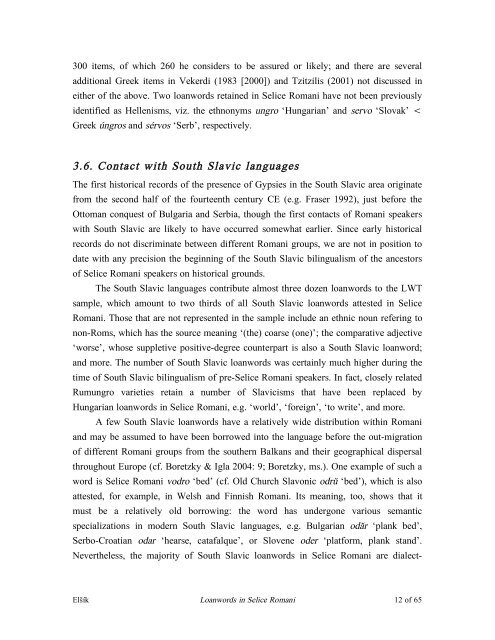Loanwords in Selice Romani, an Indo-Aryan language of Slovakia 1 ...
Loanwords in Selice Romani, an Indo-Aryan language of Slovakia 1 ...
Loanwords in Selice Romani, an Indo-Aryan language of Slovakia 1 ...
Create successful ePaper yourself
Turn your PDF publications into a flip-book with our unique Google optimized e-Paper software.
300 items, <strong>of</strong> which 260 he considers to be assured or likely; <strong>an</strong>d there are several<br />
additional Greek items <strong>in</strong> Vekerdi (1983 [2000]) <strong>an</strong>d Tzitzilis (2001) not discussed <strong>in</strong><br />
either <strong>of</strong> the above. Two lo<strong>an</strong>words reta<strong>in</strong>ed <strong>in</strong> <strong>Selice</strong> <strong>Rom<strong>an</strong>i</strong> have not been previously<br />
identified as Hellenisms, viz. the ethnonyms ungro ‘Hungari<strong>an</strong>’ <strong>an</strong>d servo ‘Slovak’ <<br />
Greek úngros <strong>an</strong>d sérvos ‘Serb’, respectively.<br />
3.6. Contact with South Slavic l<strong>an</strong>guages<br />
The first historical records <strong>of</strong> the presence <strong>of</strong> Gypsies <strong>in</strong> the South Slavic area orig<strong>in</strong>ate<br />
from the second half <strong>of</strong> the fourteenth century CE (e.g. Fraser 1992), just before the<br />
Ottom<strong>an</strong> conquest <strong>of</strong> Bulgaria <strong>an</strong>d Serbia, though the first contacts <strong>of</strong> <strong>Rom<strong>an</strong>i</strong> speakers<br />
with South Slavic are likely to have occurred somewhat earlier. S<strong>in</strong>ce early historical<br />
records do not discrim<strong>in</strong>ate between different <strong>Rom<strong>an</strong>i</strong> groups, we are not <strong>in</strong> position to<br />
date with <strong>an</strong>y precision the beg<strong>in</strong>n<strong>in</strong>g <strong>of</strong> the South Slavic bil<strong>in</strong>gualism <strong>of</strong> the <strong>an</strong>cestors<br />
<strong>of</strong> <strong>Selice</strong> <strong>Rom<strong>an</strong>i</strong> speakers on historical grounds.<br />
The South Slavic l<strong>an</strong>guages contribute almost three dozen lo<strong>an</strong>words to the LWT<br />
sample, which amount to two thirds <strong>of</strong> all South Slavic lo<strong>an</strong>words attested <strong>in</strong> <strong>Selice</strong><br />
<strong>Rom<strong>an</strong>i</strong>. Those that are not represented <strong>in</strong> the sample <strong>in</strong>clude <strong>an</strong> ethnic noun refer<strong>in</strong>g to<br />
non-Roms, which has the source me<strong>an</strong><strong>in</strong>g ‘(the) coarse (one)’; the comparative adjective<br />
‘worse’, whose suppletive positive-degree counterpart is also a South Slavic lo<strong>an</strong>word;<br />
<strong>an</strong>d more. The number <strong>of</strong> South Slavic lo<strong>an</strong>words was certa<strong>in</strong>ly much higher dur<strong>in</strong>g the<br />
time <strong>of</strong> South Slavic bil<strong>in</strong>gualism <strong>of</strong> pre-<strong>Selice</strong> <strong>Rom<strong>an</strong>i</strong> speakers. In fact, closely related<br />
Rumungro varieties reta<strong>in</strong> a number <strong>of</strong> Slavicisms that have been replaced by<br />
Hungari<strong>an</strong> lo<strong>an</strong>words <strong>in</strong> <strong>Selice</strong> <strong>Rom<strong>an</strong>i</strong>, e.g. ‘world’, ‘foreign’, ‘to write’, <strong>an</strong>d more.<br />
A few South Slavic lo<strong>an</strong>words have a relatively wide distribution with<strong>in</strong> <strong>Rom<strong>an</strong>i</strong><br />
<strong>an</strong>d may be assumed to have been borrowed <strong>in</strong>to the l<strong>an</strong>guage before the out-migration<br />
<strong>of</strong> different <strong>Rom<strong>an</strong>i</strong> groups from the southern Balk<strong>an</strong>s <strong>an</strong>d their geographical dispersal<br />
throughout Europe (cf. Boretzky & Igla 2004: 9; Boretzky, ms.). One example <strong>of</strong> such a<br />
word is <strong>Selice</strong> <strong>Rom<strong>an</strong>i</strong> vodro ‘bed’ (cf. Old Church Slavonic odrŭ ‘bed’), which is also<br />
attested, for example, <strong>in</strong> Welsh <strong>an</strong>d F<strong>in</strong>nish <strong>Rom<strong>an</strong>i</strong>. Its me<strong>an</strong><strong>in</strong>g, too, shows that it<br />
must be a relatively old borrow<strong>in</strong>g: the word has undergone various sem<strong>an</strong>tic<br />
specializations <strong>in</strong> modern South Slavic l<strong>an</strong>guages, e.g. Bulgari<strong>an</strong> odăr ‘pl<strong>an</strong>k bed’,<br />
Serbo-Croati<strong>an</strong> odar ‘hearse, catafalque’, or Slovene oder ‘platform, pl<strong>an</strong>k st<strong>an</strong>d’.<br />
Nevertheless, the majority <strong>of</strong> South Slavic lo<strong>an</strong>words <strong>in</strong> <strong>Selice</strong> <strong>Rom<strong>an</strong>i</strong> are dialect-<br />
Elšík <strong>Lo<strong>an</strong>words</strong> <strong>in</strong> <strong>Selice</strong> <strong>Rom<strong>an</strong>i</strong> 12 <strong>of</strong> 65


